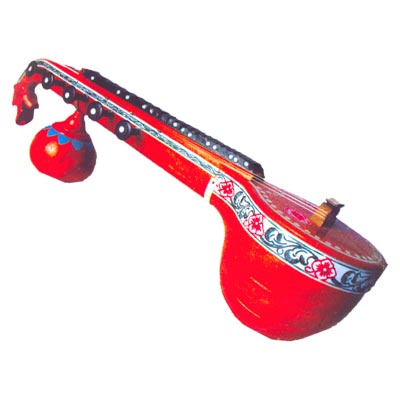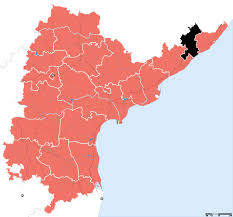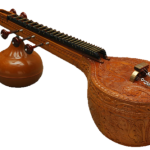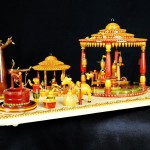 After a long hiatus, we reconvene with an article on Andhra Arts & Crafts. The Handicrafts of Andhra often blend with the Fine Arts. Perhaps the best example of this comes from the Uttarandhra region, with a name that has a storied history and background: Bobbili Veena.
After a long hiatus, we reconvene with an article on Andhra Arts & Crafts. The Handicrafts of Andhra often blend with the Fine Arts. Perhaps the best example of this comes from the Uttarandhra region, with a name that has a storied history and background: Bobbili Veena.
History
While the Bobbili Veena is today seen more as a toy than an august instrument of music, the Bobbili veena has nonetheless carved out its own name in the world of crafts. In fact, it historically had a golden age under the Rajas of Bobbili, and the instrument was a serious one for musical performances in the small kingdom. It was frequently given as a gift, and as most of the pre-modern varieties were, was often gilded.
Prior to the rise of Bobbili, the Sarasvati veena of Thanjavur was imported to the municipality. However, given the disorder and chaos of the period, this trade was soon interrupted. Challenge became chance for opportunity. The history of this lovely vaadhya is one that demonstrates the pride-of-work and patronage that was popular in coastal Andhra:
“a craftsman from Vizianagaram, Musanna Chinayya, challenged the artisans of Bobbili and their patron to craft quality veenas. Raja Ravu Venkata Kumar Krishna Ranga Rao, the then zamindar of Bobbili Samsthanam, who was a connoisseur of music, accepted the challenge and asked Sarvasiddhi Acchanna, who belonged to the [goldsmith] Viswa Brahmin community, to craft a veena of exceptional quality. Sarvasiddhi Acchanna, along with his brother Sarvasidhi Appala Swami Maistry, crafted the first Bobbili Veena in less than two months. ” [2]
Characteristics
“The Potti Veena, which preceded the Bobbili Veena, was a smaller instrument and was roughly 42 inches long. The Bobbili Veena, on the other hand, is roughly 54 inches long.” [2]
Interestingly, the Bobbili veena was a proper musical instrument in its own right. However, through the passage of time and the paucity of patronage, it adapted by becoming a collector’s item and standalone craft. Despite its widespread admiration, it is worth considering its situation today. Given their precarious position, many of these master craftsmen have supplement their work by producing not just the miniature or instrumental veenas, but also tamburas and a host of other vaadhyas. Gollapalli is the primary satellite village of Bobbili, where these masterpieces are manufactured. [3]
The goldsmith community, who are called vishwabrahmins or more commonly and correctly called vishwakarmas, were once known for being the village karnams prior to the Kakatiya era. Later dispossessed of this role, many returned to smithying, and crafted items of great beauty. The bobbili veena is one of the most famous and likely one of its most beautiful. It is very much central to the heritage of Uttarandhra in particular, and greater Andhra in general. The state of the community today speaks volumes of the priorities of the people of AP. Fortunately, it received a Geographical Indicator some years ago.
“Bobbili Veenas are also known as ‘ekandaveena’ as they are made from a single piece of wood. It has earned the GI tag in the year 2012.” [1]
Process
“Bobbili in Vizianagaram district of AP is world renowned for the Veenas manufactured here, which enjoys the status of a royal instrument. It was patronized by the kings of Bobbili, who were considered as rich patrons of music. It is made from pure jackfruit wood while the frets of Bobbili Veenas are made of bell metal with the lion’s head carved at one end.”[1]
The process of making the Bobbili specialty is very much similar to that of the standard veena. They generally made from a single piece of jackfruit wood. Along with the metal frets, black powder is added for colour and honey wax for finish.
“The diameter of the Bobbili Veena trough is roughly 14.5 inches and it has seven frets made of bell metal.” [2]
The resonator (thumba) is made from an hollowed out gourd. This is set out to dry for 3 days before being integrated into the jackfruit wood frame. In order to conduct the vibration from the string down to the resonator, a metal pipe is fixed to the gourd.
However the standout feature of the Bobbili veena that sets it apart from the rest is the bright and ornate painting of the instrument. At 8 hours a day, it takes about a month to produced a finished product. With the exception of strings and colours (brought from Mumbai) it is almost wholly locally sourced. This artistic aathodya is prize gift for any guest.
Future
The future of the Bobbili veena is in many ways parallel to the future of Andhra Pradesh. A populace that demands everything but invests nothing in its own community and its own culture, is bound to be replaced by imports. Another issue is the reduced availability of jackfruit wood—one that should be easily rectified. For all the talk of sustainability and environmentally-friendly, plastic toys and factory-instruments continue to outsell the products of meticulously crafting artisans.
Approximately 40 families continue to manufacture these beautiful specimens of musical artisanship. A point of note is that existing veenas of any variety are also repaired here at a fair rate. “However, though much seems to have been done to preserve the manufacturing of this beautiful ‘Lion faced’ instrument, the makers, chiefly the Sarvasiddhi family and others of Gollapalli village, which is situated around 20 km from Bobbili, claim that this is a dying art as there is hardly any money in it. ” [2]
It is not for lack of quality, but lack of judgment. When fashionability and price is prized over value and quality, and novelty over heritage, citizens chase after the trivial and trite. The Bobbili veena is both instrument and craft, and an intrinsic part of the heritage of Andhra. With the residuary or rump state acting true to this characterisation, the public stands at the precipice. Whether it will become inflection point is very much a weathervane for not only the arts & crafts direction of the state, but the very culture itself. If elites and wealthy businesspersons do not give patronage, the middle class well-to-do should take up the role in their stead and ensure the craftsmen of this melodious creation are given their due. One hopes that the veenas of the pulis of Bobbili will once again roar throughout the state.
“Earlier, the zamindars would pay the craftsmen a monthly salary for manufacturing the veenas.” [2] “P Narayanamma, a veena player from Chennai, said, “At the end of the day, any product should have takers. Most Telugus do not seem to have the time for classical music now. Unless there is a revival of classical music in AP, such craftsmen will suffer and the instruments will die out.” [2]
Bobbili veena, made in Bobbili #AndhraPradesh, is renowned for its unique design, durability & craftsmanship. #GeographicalIndication pic.twitter.com/D01E8seskV
— Incredible!ndia (@incredibleindia) June 28, 2017
References:
- Lepakshi Handicrafts. https://lepakshihandicrafts.gov.in/
- http://timesofindia.indiatimes.com/city/visakhapatnam/Melody-of-Bobbili-Veena-dying-out/articleshow/47451422.cms
- http://gaatha.com/bobbili-veena/







